The Barrowland Ballroom by Peter Ross. Photographs by Anne Ward
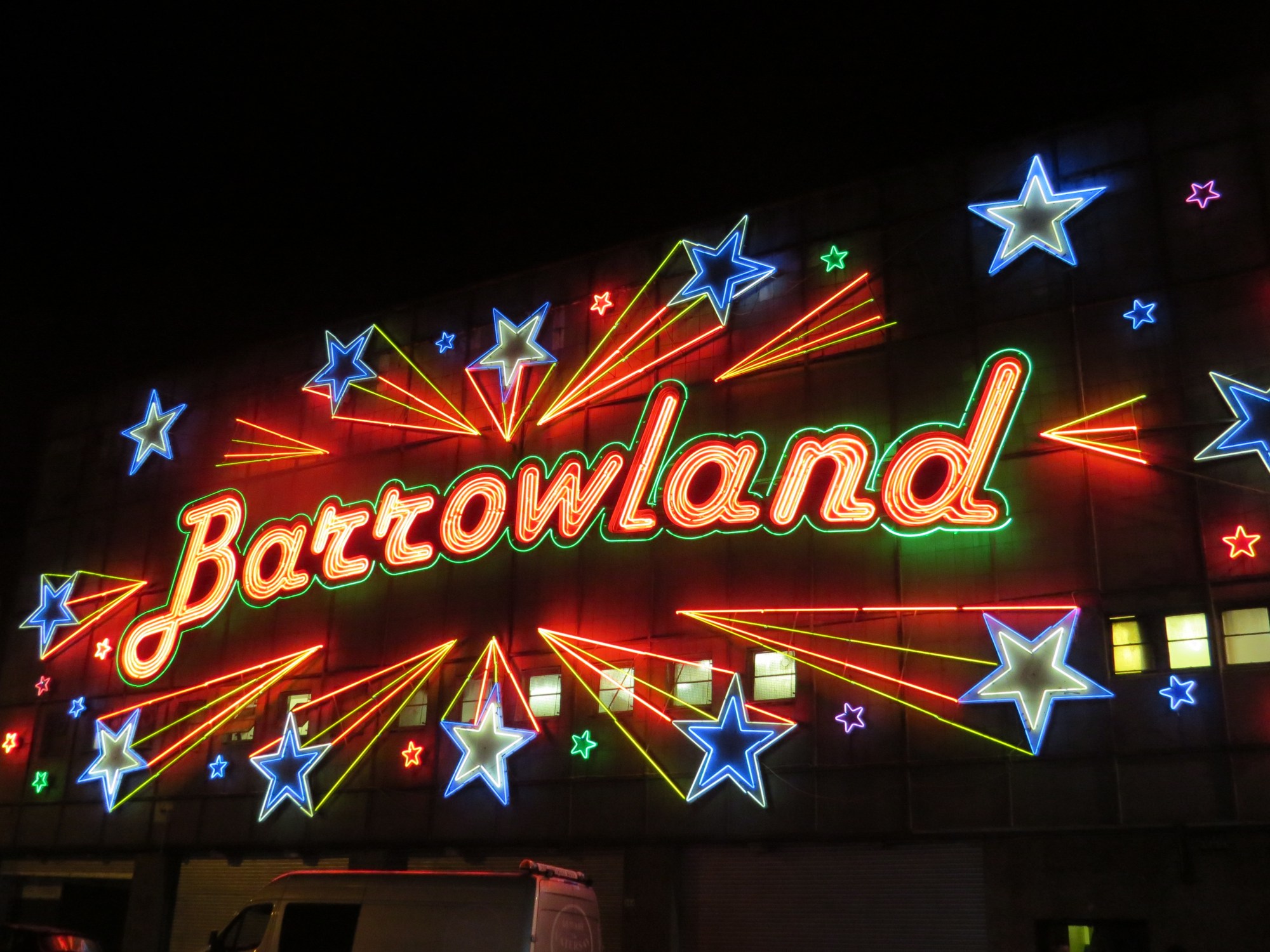
We’re really looking forward to The Passion of Harry Bingo, the new book from award-winning writer, Peter Ross, due in August. In the meantime to keep you going we’re re-running the popular photo essay by Peter and photographer Anne Ward on the legendary Barrowland Ballroom. For more of Anne’s writing and photographs check out her fabulous books, Nothing To See Here and Northern Delights. Keep your eyes peeled for news of Anne’s new book, Way Out West, coming soon! Thank you Anne and thank you Peter.
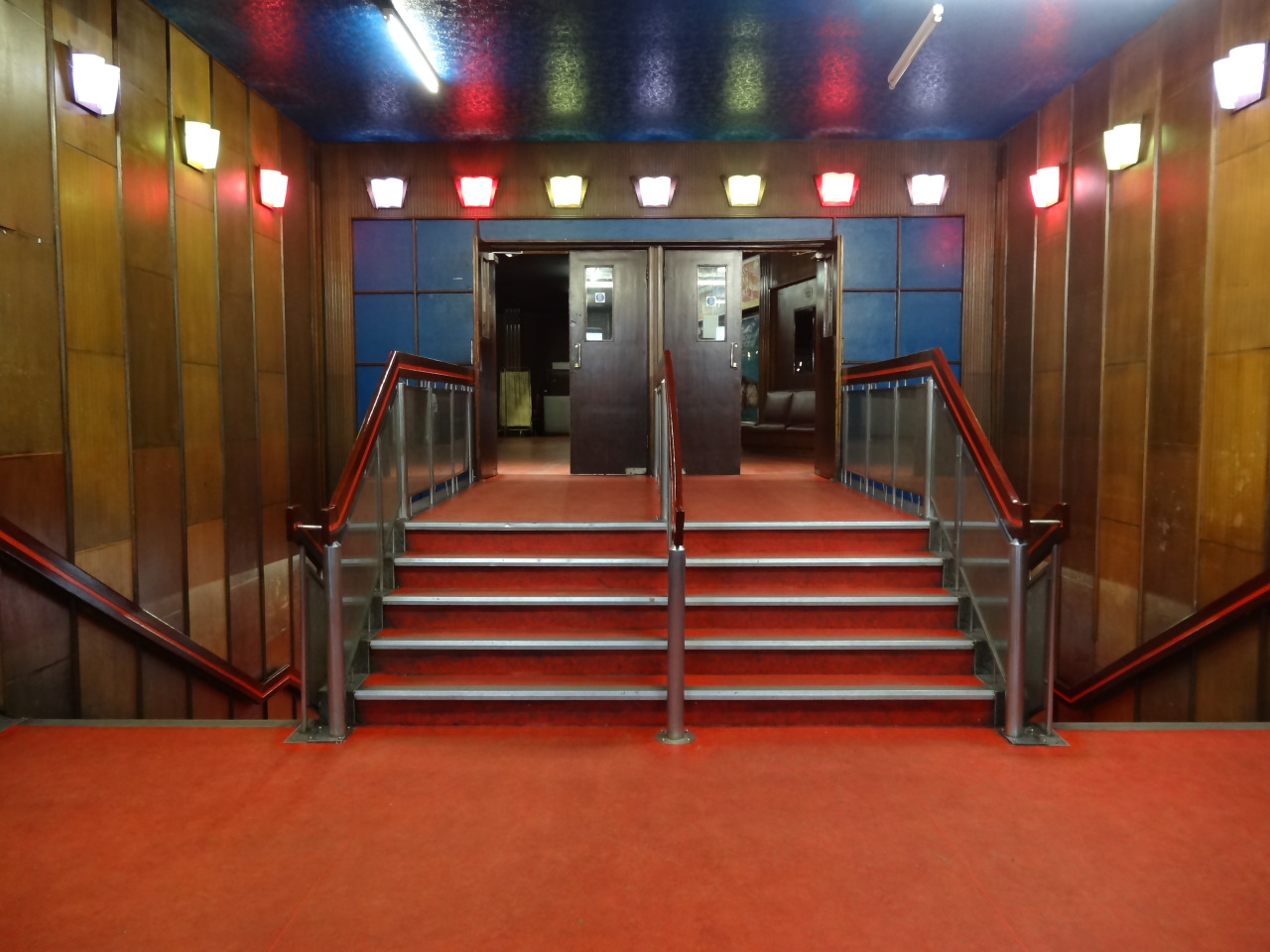
Double doors, Barrowland, Glasgow (Anne Ward)
TEN letters. Thirty-six stars. Two hundred and forty volts. Put that like that it does not sound like much, but the neon sign of the Barrowland Ballroom is so much more – a gaudy, gallus pleasure beacon which for generations has shone out into the Glasgow night, reflected in the mirrored windows of rock band coaches, in rain-choked Gallowgate gutters, and in the eyes of music fans intent on the good time to end all good times. “What can ye say, darlin’?” shrugged one young woman, standing in the queue for Biffy Clyro. “The Barrowlands is The Barrowlands.” Put like that, again, it did not sound like much, but it was a statement of pure love and everyone who heard it understood exactly what she meant.
It was 1934 when Maggie McIver, “the Barras queen”, did a stately pleasure-dome decree. She had founded the famous market some years earlier, and now had the idea that her stall-holders ought to have a room of their own for conviviality and dancing, a place to slake throats parched by long days hawking wares – everything, as they say here, from a needle to an anchor. It opened on Christmas Eve, was known at that time as the Barrowland Palais de Danse, and soon had a house band, Billy McGregor and the Gaybirds, whose showmanship attracted a clientele far wider than that of the market traders. It entered Glasgow’s bloodstream and, all these years later, is part of the city’s pulse.
The Gaybirds were still playing by 1958 when a fire destroyed the original ballroom. On reopening at Christmas 1960, it looked much as we see it today. Foxtrot, jitterbug, swing, twist, jive, whatever makes you feel alive – the hall has seen the dance crazes come and go, decades of joy and lust and heartbreak worn into that wooden floor, those emotions rising now, every show night, sensual and spectral in the air, just as the faint scent of resin rises on opening an antique jewellery box.
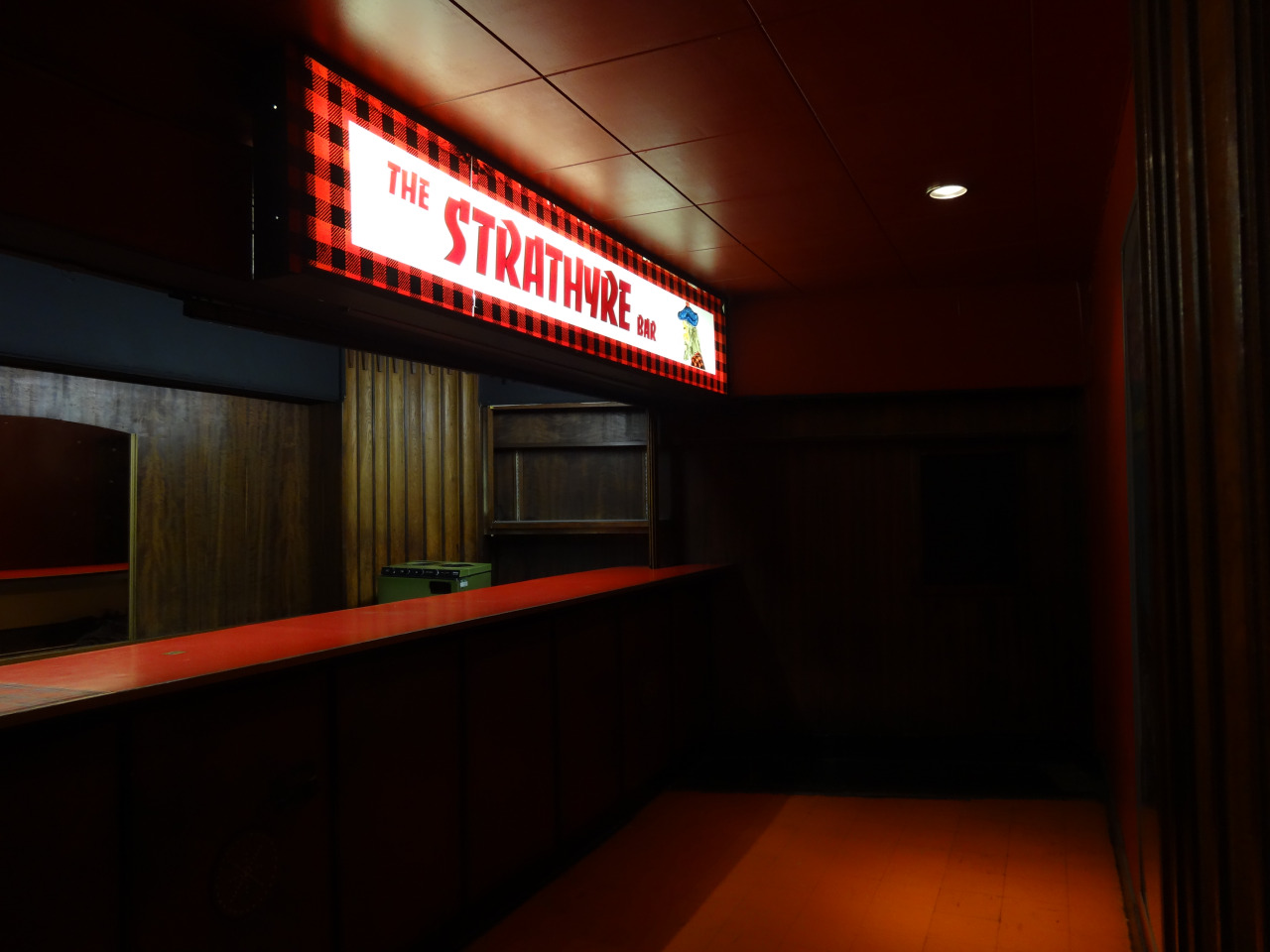
The Strathyre Bar, Barrowland, Glasgow (Anne Ward)
Since 1983, the ballroom has been a pole star for touring bands, many of whom regard their first concert as a rite of passage and every subsequent show as a homecoming. Shirley Manson has performed here on seven occasions, the first with Goodbye Mr Mackenzie in 1987 and most recently with Garbage in 2012. “The Barrowlands is the talisman of my entire career,” she says. “That sounds so dramatic, but, then, life is short, why not be dramatic? It’s a place that began my adventure, and every time I come back I’m reminded of that. Actually, I made a little speech to my band the last time we were there, backstage before we went on, saying how privileged I felt to be able to keep coming back 30 years from the first time I played.
“I’ve played all over the world, in venues of all sizes, and still look forward to coming back to the Barrowlands because there’s something incredibly magical about it. And it’s not just me who has this view. You travel the world and the minute you meet a musician who knows you’re Scottish, one of the first words out their mouth is ‘Barrowlands’. Everyone connects with that place. It’s the quintessential venue of our entire nation.”
Manson refers to the ballroom as “she” – “I always attribute greatness to women”. Does she, then, wish to send a sisterly greeting? “Barrowlands already knows how much I love her. There’s nothing more that needs to be said between me and her, other than I just hope coming generations understand the value in her and safeguard her future.”
Going to see a band here is different from seeing them anywhere else in Glasgow, or indeed in the whole of Scotland. The energy and atmosphere; the smell of booze and burgers and perfume and anticipation. Dust and dry ice drift through blue, orange and pink lights. The ceiling is set with diamonds and stars; the latter being sought-after souvenirs for the musicians who play here. David Bowie is said to have one framed in the toilet of his Paris home.
At around 7pm, when the doors open, the crowds pour in like bevvy down a drouthy throat. Above them, hanging from the ceiling, is a cart wheel encircled in red neon. This is what remains of a model – a market trader pushing a barrow – that used to be on the roof. When the original ballroom burned, all that survived was this solitary cart wheel, so, on rebuilding, it was given pride of place above the stairs. Few, in their excitement to get in and see the band, even notice this holy relic, but it is the heart of the place, and to pass beneath is a sort of benediction. “It almost feels,” says Nuala Naughton, author of Barrowland: A Glasgow Experience, “that when you are walking up those stairs, the mantle of permission to go mental comes down and covers you.”

Neon note, Barrowland Bar, Glasgow (Anne Ward)
In the downstairs bar, punters sup in the glow of neon treble clefs. A stern sign warns Anyone Caught Throwing Drinks Will Be Immediately Ejected With No Refund. Some hope. The flung pint, love it or hate it, is one of the signature sights of this place, lager sparkling in the spotlights as a band take the stage in Lowry silhouettes. It may be to do with the location of the ballroom, the fact that it is earthed in the present east end and ancient centre of Glasgow, connecting it to some primal wildness, some Weegie leyline, which gives gigs here their reckless, outlaw air. Whatever the reason, there is at times a profound connection between that electric trinity – band, crowd and place. One thinks, perhaps, of Dylan in 2004, grinning and shaking his head at being barely able to hear himself sing Like A Rolling Stone. One thinks of Big Country doing Chance at Hogmanay. And one thinks, most of all, of The Pogues.
It was September 11, 1985. The previous night, as Scotland played Wales in Cardiff, Jock Stein had suffered a heart attack and died. Now, halfway through the Pogues’ set in Glasgow, Cait O’Riordan dedicated I’m A Man You Don’t Meet Every Day to the late Celtic manager’s memory. The crowd, as one and at once, begin to chant his name and did not stop for a long time. It was a perfect moment, rough magic, more moving than any speech at any wake.
“The Barras defined the band,” says Spider Stacy of The Pogues. “It seemed a perfect fit: the band for the venue and the venue for the band. It’s been a real regret to me that we haven’t gone back and played there for a long time. Some rooms just have something in the air. When the room is full of people and the right band is on stage, there’s an alchemy. The people who are there watching are the ones that make it happen. It’s a testament to the audience’s ongoing ability to transform the evening from just another gig into something that sears itself on to your memory.”
Spider talks about “The Barras”, a term which, if one is being pernickety, should be used only in reference to the market. The Barrowland Ballroom is the proper name of the dancehall. But, of course, everyone calls it Barrowlands. This is a pet hate of the manager Tom Joyes, who insists on “Barrowland”, singular, but he’s fighting a losing battle. The plural sounds more natural, and for good reason – those of us who love this place each carry a slightly different personal version of it within our hearts and memories. The Barrowlands, regardless of title deeds, belongs to us all.
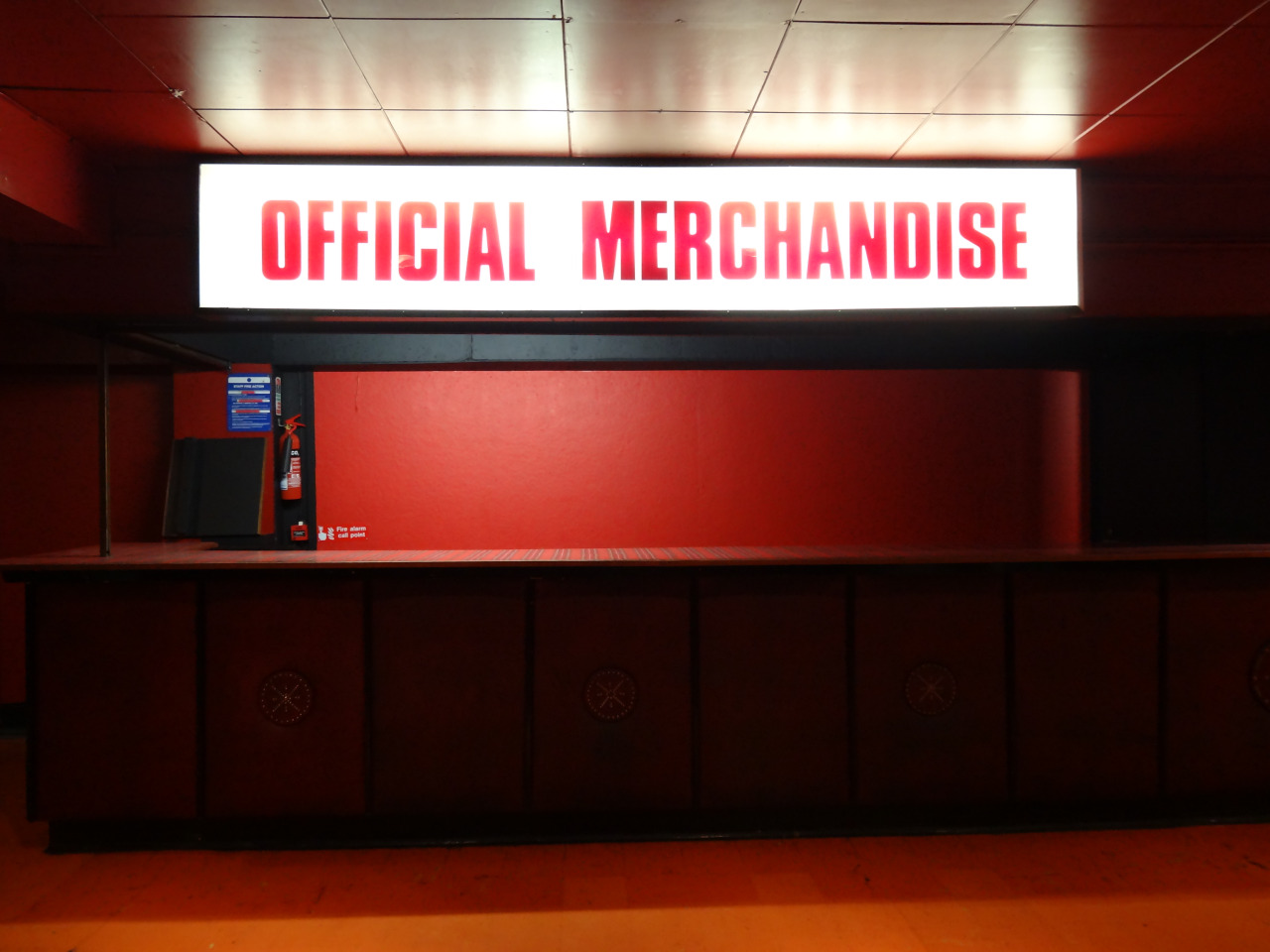
Official merchandise stall, Barrowland. Glasgow (Anne Ward)
We should be honest about the things we love, and honesty requires an acknowledgement of the darkness of the Barrowlands. Nearly 2,000 fans going daft for Chelsea Dagger or Chocolate Girl tends to dampen the feelings of melancholy and even faint dread, but they are always present in the place, and especially apparent earlier in the day or in the small hours when the ballroom is quiet. One can speculate about the causes of this. One can talk about the serial killer Bible John, for whom the ballroom became a hunting ground between 1968 and 1969, his tenebrous footprints part of the patina of that floor. Whatever the reason, the feeling is real. The dancer and choreographer Michael Clark detected “an amazing atmosphere of romance and violence” while working alone through the night, creating his Barrowlands Project in the ballroom two years ago. “You can sense the history of the place,” he recalls. “I love it. Glasgow has got this glamour to it, but it’s quite brutal as well. There’s a frightening aspect to the glamour and there’s something very attractive in that.”
The broadcaster Tom Morton believes that part of the appeal lies in what the French call “nostalgie de la boue” – that desire to get back to an earthy notion of what rock ’n’ roll ought to be about; back to the streets, down and dirty, smuggling quarter bottles in your socks through a toilet window.
“Barrowlands,” he says, “is like an interactive industrial heritage park, only for music.”
During the 1970s and into the early 80s, Barrowlands struggled. The fear and disruption caused by the Bible John murders and investigation, and the simple fact of changing fashion, disco usurping “the dancin’”, meant its popularity nosedived. In 1983, however, one single creative decision kickstarted its future. Simple Minds decided to film the video for their new single Waterfront there – tapping directly into that association with Glasgow’s industrial heritage.

Private, Barrowland, Glasgow (Anne Ward)
Pop and rock musicians had performed in the ballroom before, but only the odd couple of songs squeezed between Gaybirds sets. No one had ever considered putting on a whole show. Waterfront was inspired by the thought of Glasgow being eternal, a sort of prayer for the resurrection of a once proud city. The pulse of the song – dum de-dum de-dum de-dum – was the beat of the tidal river. Bruce Findlay, the then manager of Simple Minds, had a concept that the video for Waterfront should be filmed in an abandoned warehouse by the Clyde. Logistics made this impossible, so when the promoters Regular Music suggested that this old, half-forgotten dancehall in the east end might be available, his ears pricked up.
He walked in. It smelled a bit foosty, but looked perfect. Those stars on the ceiling, that bounce in the floor. He shouted into the emptiness and liked the sound. Not too echoey; not completely dead. Waterfront was filmed there on November 20, 1983, a video which established an idea of Barrowlands as a place where band and audience could make their most profound communion. Through a song about rebirth, Barrowlands was reborn. It also proved a turning point for Simple Minds.
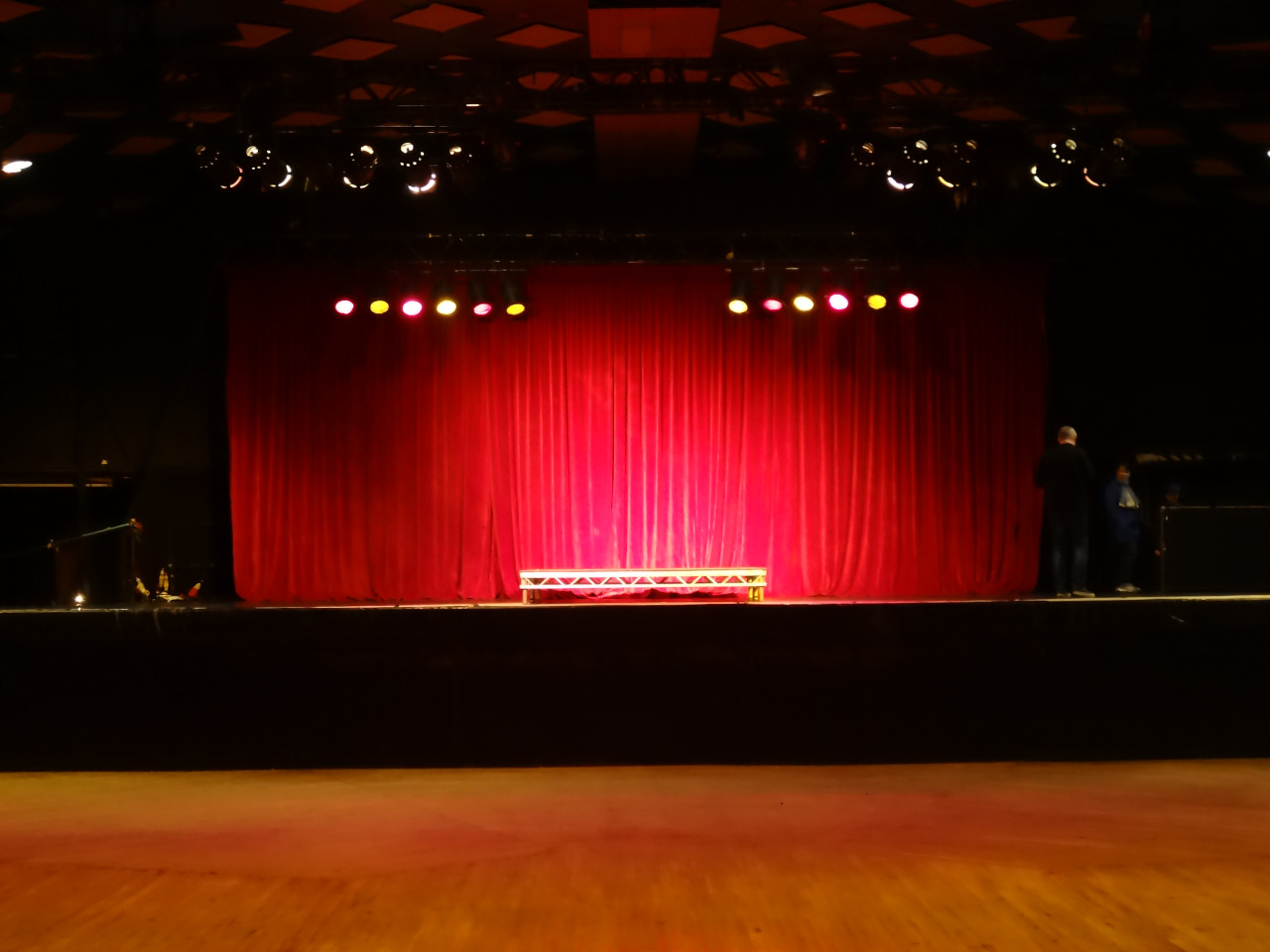
Barrowland Ballroom, Glasgow (Anne Ward)
“Yes,” says Bruce Findlay, still excited at the memory. “that was the breakthrough. The Apollo was owned by The Who, by Alex Harvey, by The Rolling Stones. The Barrowland was ours. We’d already had a big hit record with New Gold Dream, but in terms of becoming the people’s champions, that opened the doors. And I love the fact that we were party to that place being revitalised. We made a no-go area into a ‘go’ area.”
Since that Simple Minds show, there have been more than 1800 headline performances at the venue. Most of these are commemorated in the Album Pathway created, in a nearby park, by the artist Jim Lambie – one hundred metres of coloured concrete strips, each set with the name of the act and the date on which they performed.
To walk along this path, in the pouring rain, in the company of the Barrowlands’ greatest fan is to understand just how meaningful the place can become in our lives. “Been to that one,” he says, nodding at the path. “That one. That one. That one.”
Campbell Stewart, a fiftysomething from Airdrie with a Hobbit belly and a Gandalf beard, reckons he has attended more shows there than any other paying punter. Hunners. His first, Motorhead in 1984, was appropriate for such a hard rock aficionado, but his taste is eclectic to say the least. He is surely the only person in Scotland to have enjoyed concerts by both Simply Red and Sepultura. EMF, INXS, SLF – he has seen them all.
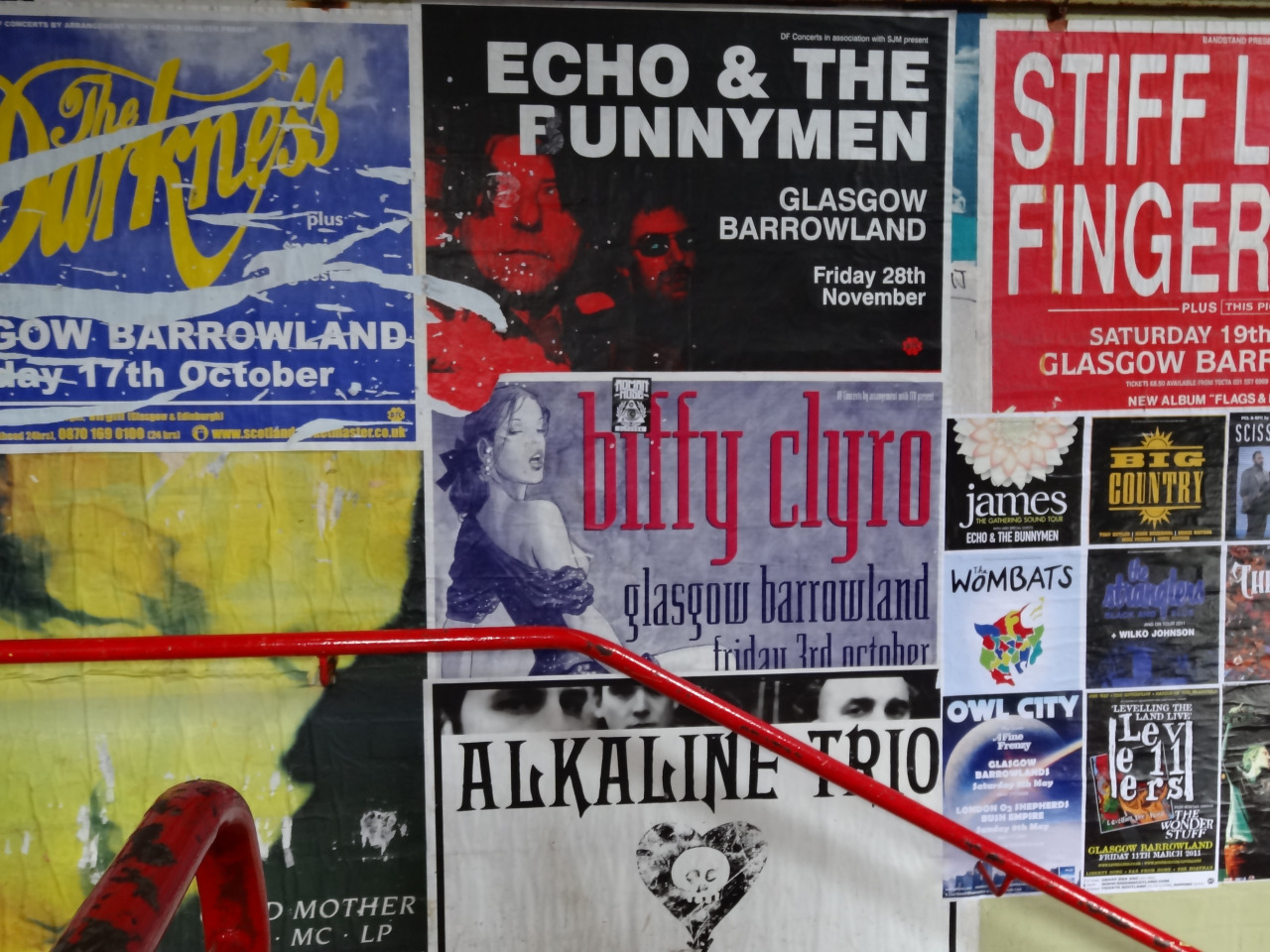
Old Posters, Barrowland, Glasgow (Anne Ward)
As we’re talking, a middle-aged woman walks over. “Brings back some memories?” she asks. This is Carol, out walking Bo, a black Lab, and Randy, a Labradoodle. She lives nearby and often takes the dogs past the big sign. “That neon, man. Incredible.”
Stewart nods. “That’s where the buzz starts.”
“Absolutely. It’s just an amazing place. Hopefully it’ll be there forever.”
We carry on up the path, heading for Deep Purple, and Carol, Bo and Randy go on their way. It has been a brief encounter of a very Glasgow, a very Barras sort; one based on a pleasure understood and shared.
“Alright, guys,” she calls over her shoulder. “Mibbe see you in the Barrowlands!”
![]()
Daunderlust: Dispatches from Unreported Scotland by Peter Ross is available to buy here
